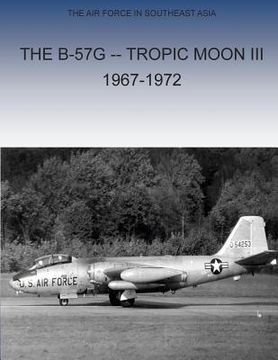Synopsis "The B-57G Tropic Moon III, 1967-1972 (in English)"
As in World War II and the Korea police action, the enemy in Southeast Asia sought the protective concealment of darkness to move his troops and supplies. Although U.S. tactical aircrews cut roads and destroyed moving vehicles during daylight hours, they were ineffective at night. Jungle vegetation and mountainous terrain amplified their difficulties in finding and attacking the trucks, watercraft, and troops that poured southward each night through the maze of roads, footpaths, and streams that constituted the so-called Ho Chi Minh Trail in eastern Laos. Casting about for an aircraft capable of interdicting the infiltration flow at night, the Air Force finally settled on a modified B-57 as the most suitable vehicle on which to mount and test new sensors and weapons in a night attack role.Conceived in 1967 as Project: Tropic Moon III, the B-57G was the first jet bomber specifically configured for self-contained night attack sorties in Southeast Asia. Within a relatively short time, the Air Force modified, tested; and flew the B-57G against hostile targets. When the Air Force decided that the time had come to withdraw the B-57Gs from Southeast Asia, Secretary of the Air Force Robert C. Seamans, Jr., wrote to the Chief of Staff of the Air Force that "it seems to me appropriate that we record and evaluate our experiences with the B-57Gs from concept formulation through redeployment to highlight those lessons which would be valuable in developing and employing similar systems in the future." That task was assigned to the Director of Operations in the office of the Deputy Chief of Staff for Plans and Operations at HQ USAF. Maj. Gen. Clifford D. Hargrove, the Deputy Director of Operations, asked the Chief of Air Force History for "assistance in preparing a historical study of the B-57G program." Mr. Richard A. Pfau a temporary staff member of the office of the Chief of Air Force History, undertook the task of preparing the desired monograph. Although he found most of his material in the files of the Albert F. Simpson Historical Research Center at Maxwell Air Force Base, he exploited other repositories wherever possible, Before he returned to his university studies, Mr. Pfau prepared a first draft of the desired study. That manuscript and his notes remained inactive until early 1977, when they were sent to the Albert F. Simpson Historical Research Center for historical review. Mr. William H. Greenhalgh, Jr., a staff historian at the center, conducted additional research, edited Mr. Pfau's work, and added material where necessary. The result is this study of the B-57G program from inception to termination.

